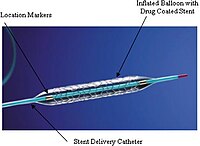
Photo from wikipedia
Background There are limited data regarding the impact of bioresorbable polymer drug eluting stent (BP-DES) compared to durable polymer drug eluting stent (DP-DES) in patients treated with percutaneous coronary intervention… Click to show full abstract
Background There are limited data regarding the impact of bioresorbable polymer drug eluting stent (BP-DES) compared to durable polymer drug eluting stent (DP-DES) in patients treated with percutaneous coronary intervention using ultrathin stents in left main or bifurcations. Methods In the RAIN registry (ClinicalTrials NCT03544294, june 2018 retrospectively registered) patients with a ULM or bifurcation stenosis treated with PCI using ultrathin stents (struts thinner than 81 μm) were enrolled. The primary endpoint was the rate of target lesion revascularization (TLR); major adverse cardiovascular events (MACE, a composite of all-cause death, myocardial infarction, TLR and stent thrombosis) and its components, along with target vessel revascularization (TVR) were the secondary ones. A propensity score with matching analysis to compare patients treated with BP-DES versus DP-DES was also assessed. Results From 3001 enrolled patients, after propensity score analysis 1400 patients (700 for each group) were selected. Among them, 352 had ULM disease and 1048 had non-LM bifurcations. At 16 months (12–22), rates of TLR (3.7% vs 2.9%, p = 0.22) and MACE were similar (12.3% vs. 11.6%, p = 0.74) as well as for the other endpoints. Sensitivity analysis of outcomes after a two-stents strategy, showed better outcome in term of MACE (20.4% vs 10%, p = 0.03) and TVR (12% vs 4.6%, p = 0.05) and a trend towards lower TLR in patients treated with BP-DES. Conclusion In patients with bifurcations or ULM treated with ultrathin stents BP-DES seems to perform similarly to DP-DES: the trends toward improved clinical outcomes in patients treated with the BP-DES might potentially be of value for speculating the stent choice in selected high-risk subgroups of patients at increased risk of ischemic events. Trial registration ClinicalTrials.gov Identifier: NCT03544294 . Retrospectively registered June 1, 2018.
Journal Title: BMC Cardiovascular Disorders
Year Published: 2020
Link to full text (if available)
Share on Social Media: Sign Up to like & get
recommendations!